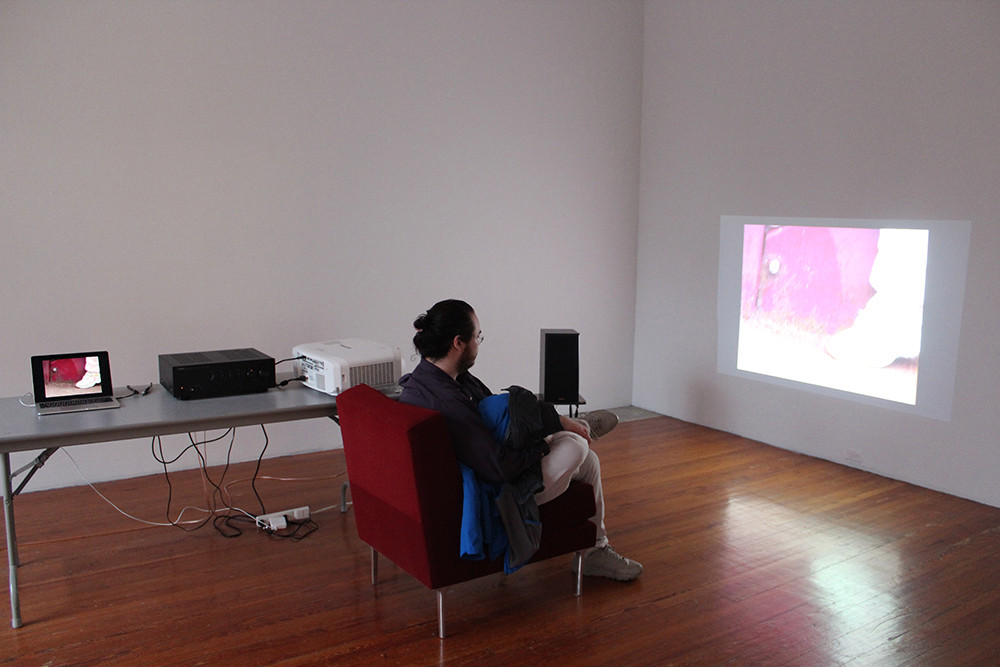[ad_1]

Photo Carter Seddon.
Jason Hirata’s solo show “Sometimes You’re Both,” on view at New York University’s 80 Washington Square East gallery (80WSE) through February 23, comprises six video works loaned to Hirata by other artists and collectives—Hannah Black, Adjua Gargi Nzinga Greaves, Trajal Harrell, Carissa Rodriguez, Hito Steyerl, and New Red Order. All the loans are pieces that he once aided in realizing. Since 2008, Hirata has worked freelance for various artists and museums, most often as a video technician. The “Sometimes” pieces are presented using seating and equipment from previous exhibitions Hirata helped install at 80WSE, where he often serves as an art handler or technician. He compares his support of other artists to devices that make shows run, like projectors and cables. Below, the artist explains why he considers his installation of the videos.
I first showed a version of this project last year at Kunstverein Nürnberg. That exhibition, titled “25 October, 2015 — 12 May, 2019,” featured objects, videos, and sound pieces that I made for twenty-four other artists over the course of a few years. This temporal framework was a way to bring an autobiographical sense of time into the story. For “Sometimes You’re Both,” I’m showing only videos that I helped make as work for hire. One student asked me if the show was like a demo reel, and I realized it totally is.
Things like demo reels or even credits are more common in film than in video art. Hito Steyerl’s Unbroken Windows [2018] is more of a film than anything else I’m showing: that’s partially why it’s in its own room. Credits do roll at the end of Steyerl’s piece, but not the others. For Unbroken Windows, I was the production manager; Steyerl hired a cast and crew. I shot and/or edited some of the other works. For Carissa Rodriguez’s The Girls [1997–2018], I was the studio assistant: you could say that piece is the furthest from my own creative agency. I was responsible for tasks like editing as well as encoding the files to make sure the video could be played in different situations.

Photo Carter Seddon.
Rodriguez’s video, which you see when you first walk in, is synced with another piece that’s shown in the last of five connected rooms: Adjua Gargi Nzinga Greaves’s Poetry Reading at 222 Bowery [2017]. An intense musical score plays at the end of Rodriguez’s video in the first room; that music is also the score for Greaves’ video. These videos are then synced with a third channel that isn’t visual: in the gallery’s third room, a mix of the dialogue, sounds, and music from both videos runs off of a Mac computer sitting on a cart, showing the default screensaver. Often, in video art exhibitions, people try to avoid installing works in a manner that makes the sound from one piece bleed into another, but I put the speakers for the audio channel in the middle rooms. The galleries are another platform for me to edit the videos spatially and temporally. This sort of installation is a very clear way to incorporate my own authorship.

Photo Carter Seddon.

Photo Carter Seddon.
The first time I did this type of multi-channel orchestration was while working for 80WSE last summer, synchronizing a two-channel piece for the collective Thirteen Black Cats (Vic Brooks, Lucy Raven, and Evan Calder Williams). Learning that technique while working with them was a form of inheritance: I learned a new skill and gained a new idea through the process of helping other artists solve a problem. I thought about how my personal practice unfolds within the context of a paid position, when I’m working for other authors.
The installation is meant to give prominent visual space to the exhibition’s apparatuses. Things like the cables and the Wi-Fi router are very much on view: I’m accentuating the technical support structures. The installation shots emphasize components like the tables, the sound boards, the projectors . . . things that I, as an assistant, get the privilege of working with. I want people to look at the facilities without breaking their art gaze. The chairs I use were purchased for the Thirteen Black Cats exhibition, and the projectors were purchased for the Louise Lawler show at 80WSE in 2018. I consulted for Lawler’s exhibition, and chose the projectors. In my Nuremburg show, I represented other artists’ practices more faithfully, not wanting to subsume their work into my own. Here, I’m still thinking through the ethics of distributing authorship, showing my hand a bit more while still trying to avoid subsuming the work of others.
—As told to Emily Watlington
[ad_2]
Source link

